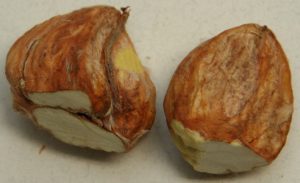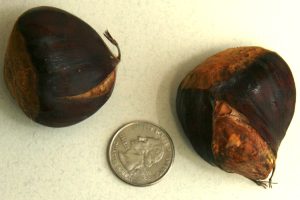For those of us who has had a chance to experience a perfectly roasted chestnut, it is a very memorable experience. We have to ask ourselves, what is it that makes a chestnut worthy of our palette? Let’s discuss the characteristics of a good chestnut and some of the things contributing to a less than a good chestnut.
The word we hear most often from customers is sweet. Are the chestnuts sweet? Chestnuts have a very mild sweetness to them if handled properly. If the chestnuts are exposed to freezing temperatures they will turn bitter even without any outward sign of having been exposed. We have seen chestnuts that turn black and mushy after being frozen and sometimes the chestnuts just turn bitter without any changes to the color or firmness of the chestnut.

Next on the list of a high quality chestnut is how long it can be stored once it has been harvested. Over the years we have received phone calls from customers about how the local store bought chestnuts rotted in the fridge in just a few days. All imported chestnuts into the USA are required to be processed in such a way to prevent bugs from being carried inside the chestnut into our nation, possibly causing lots of harm to our local trees and forests. Just about any process that kills the bugs also kills the chestnut. Once the chestnut is killed it will start decaying and the storage life will be greatly shortened. Once in the store many produce sections place the chestnuts with all the other nuts in a room temperature display. Chestnut have to remain refrigerated at all times. Chestnuts have a very high water content and will easily support the growth of molds if left stacked at room temperature.
Another important characteristic of a quality chestnut is how easy it is to peal. Let me share a secret with you. Most chestnuts when they fall from the tree are not easy to peal. Once the chestnut goes through a short sweetening process it becomes easy to peal. It is very easy to sweeten up chestnuts. Simply take the chestnuts you plan on serving out of the fridge 2 or 3 days before serving and put them on a flat surface to room temp. Do not stack the chestnuts. Put them in a place where the air can circulate around them like on a countertop. The sweetening process causes the nut kernel to shrink slightly causing the pellicle to separate from the kernel. Now you have sweet easy to peal chestnuts.

Poor quality chestnuts may have one or more of the following issues:
- Cracked shell
- Soft when squeezed
- Turned black
- Has molds, either or both internal or external molds
- Has multiple kernels
- Has a kernel with pellicle intrusion
Just because one chestnut in a whole batch of chestnuts has one or more of these issues, does it mean all the chestnuts are bad? The answer to this question is one statistics can help us with. Let’s say the farmer has set a quality standard of 95% of all the chestnuts being sold are perfect, meaning the chestnuts do not have any of the above issues. If you purchased 4 pounds of chestnut with an average of 28 chestnuts per pound, you might find 6 chestnuts with issues. Most of the issues in the above list cannot be identified in the sorting process. Some chestnuts are naturally dark and can be confused with being black and suffering from being frozen or internal rot. So the answer to this question is, there almost always will be a few chestnuts in a batch with issues even with a 99% effective sorting system.
There are three big variables associated with chestnut quality. First is Mother Nature providing a good growing season. Second is the quality of chestnuts the specific chestnut cultivar produces. And the third variable is the farmer taking care of the chestnut orchard and the post harvest handling of the chestnuts.
